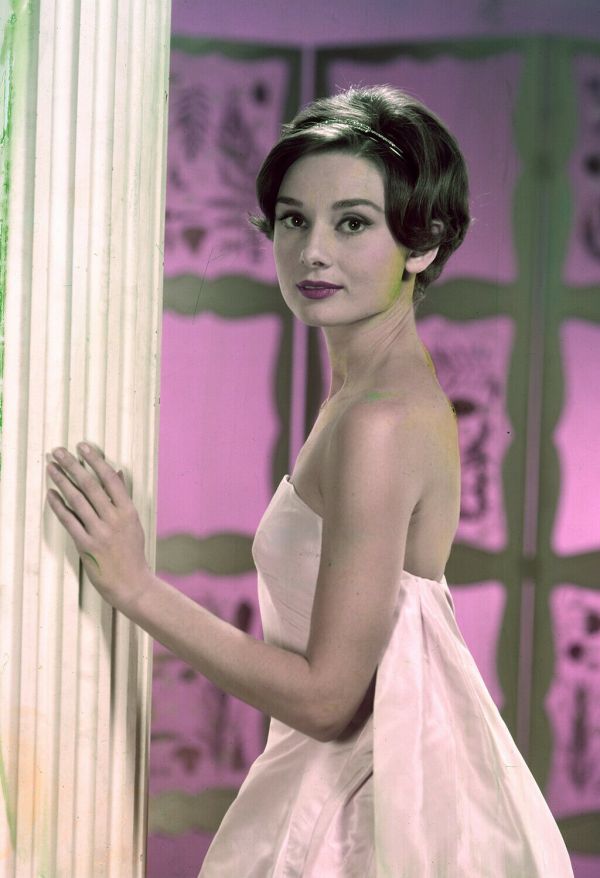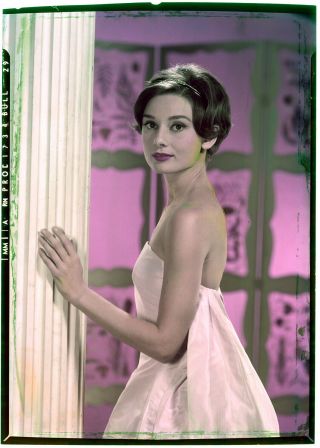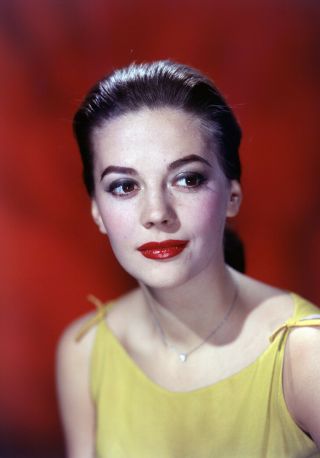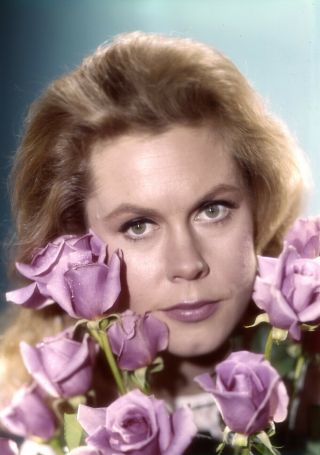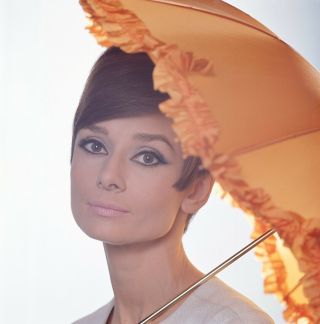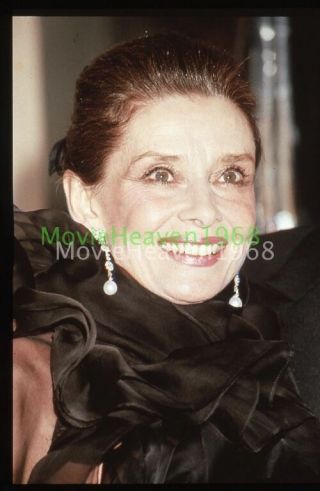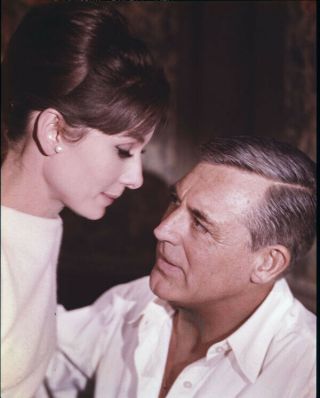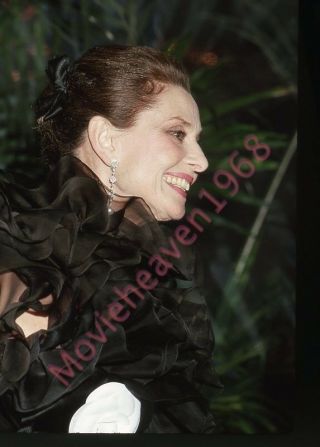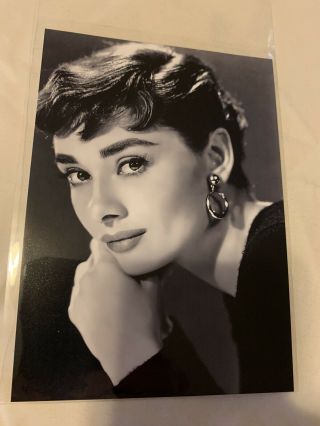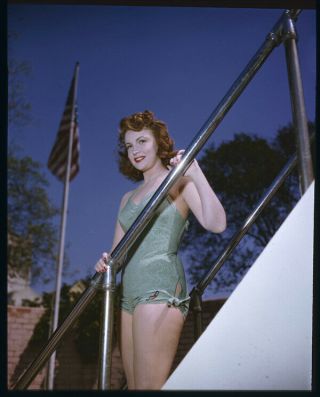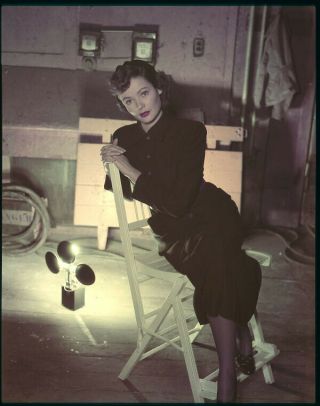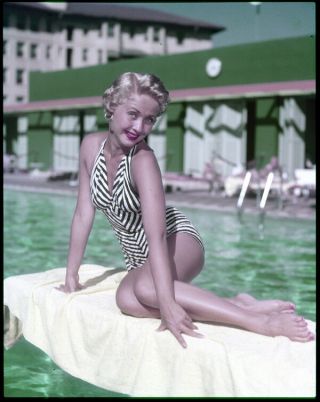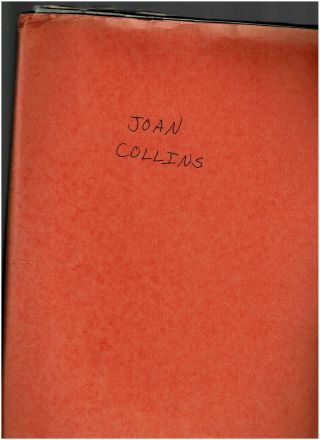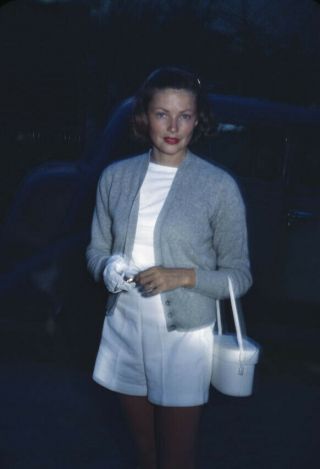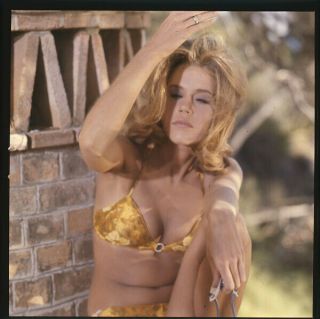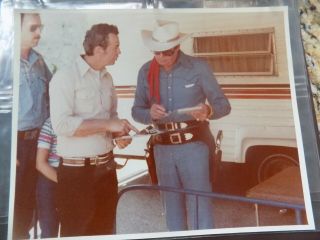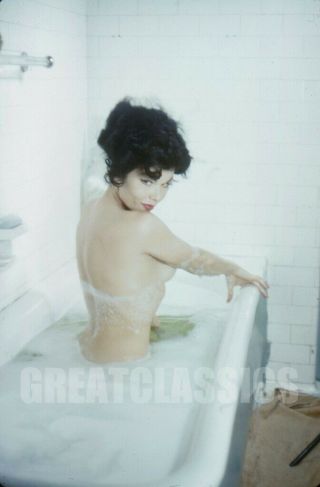Audrey Hepburn 5x7 Color Film Transparency CS Bull Green Mansions 1959
Item History & Price
Based on the popular, best-selling 1904 novel of the same name by William Henry Hudson, "Green Mansions"' journey to the screen was a long one with several studios and directors attempting to bring to life 'Rima', a mysterious, ethereal jungle sprite untouched b...y civilization. There just didn't seem to be anyone who could pull off the part effectively, at least not until it became apparent that the perfect choice was the spritely child-woman of the time, Audrey Hepburn. Ironically, the role was to prove to be the one that sexualized Hepburn's image, offering her the opportunity to move from her rather virginal gamine roles of the previous decade into one that allowed her to be a scantily clad jungle princess awakened into passion by a handsome young man (rising star Anthony Perkins).
PLEASE NOTE: This auction is for the 5x7 Ektachrome transparency only. There are no copyright or reproduction rights included in the final sale.
Guaranteed to be 100% vintage and original from Grapefruit Moon Gallery.
More about Audrey Hepburn:
Audrey Hepburn's reign as Hollywood's storybook princess lasted 15 years, long enough for her to be made a paradigm of sparkling charisma and class. From a traumatic youth in Nazi-occupied Europe, Hepburn effortlessly charmed her way into the hearts of producers, directors, co-stars and movie-goers alike, earning no less than drama's highest-profile honor for her first major film outing, "Roman Holiday" (1953). She seemed to define irrepressible, from her "Sabrina" (1954) through her deceptively sweet call girl in "Breakfast at Tiffany's" (1961) to her heartwarming rags-to-riches Eliza Doolittle in the film version of one of the last old school hit musicals, "My Fair Lady" (1964) to even late in her life when traveled the world as a high-profile spokeswoman for UNICEF. Her legacy on screen and off would be that of someone disarmingly defying her "place" and pedigree, transcending them, and in the process, becoming that rare movie star who men wanted to be with and women concurrently wanted to be.
She came from the blue blood whose vaunted elegance she would mythologize on film. Born Audrey Kathleen Ruston on May 4, 1929 in Ixelles, Belgium to noble parents who would hardly provide her an idyllic childhood, her mother, the former Ella Van Heemstra, was a Dutch baroness and her father, Anthony Joseph Ruston, was an insurance company executive. Both claimed descent from English and Scots royal houses - the surname of one he would soon add to the family moniker "Hepburn-Ruston" - and the family toggled its residences between Belgium, The Netherlands and the U.K., where both parents joined the ultra-right-wing British Union of Fascists. They also fought often, exacerbated by Joseph's drinking, prompting Ella to enroll a traumatized Audrey in an English boarding school, where she developed an affinity for ballet. Joseph walked out on the family in 1935, and four years later, with war looming over Europe, Ella moved Audrey and her two half-brothers out of harm's way to Arnhem in the ostensibly neutral Netherlands, where she enrolled her daughter in the Arnhem Conservatory. Ella instilled a rigid sense of aristocratic propriety in her daughter, but after Germany invaded The Netherlands in 1940 and she saw fascism in action, she shed her previous politics and joined the Dutch resistance.
The family suffered through bitter privation throughout the war, but Audrey continued to pursue her art and even danced at underground performances to raise money for the resistance. She also carried secret correspondence in her shoes, even though she witnessed the Germans execute two relatives and ship one of her half-brothers to a labor camp. When Germany surrendered, she found that the malnutrition and anemia that plagued her during the war limited her ballet prospects, and her distinctive, sprightly beauty helped her expand into modeling and acting, the latter beginning in 1948 with one line in the Dutch film "Nederlands in Sieben Lessen." Moving with her mother to London, she began earning some stage and minor film work, including one movie called "Monte Carlo Baby" (1951), which led to a fateful encounter with the renowned French novelist Colette. The 78-year-old author reportedly spotted Hepburn cavorting around in a hotel lobby in Monte Carlo and immediately recognized in the girl the look she wanted for an upcoming Broadway version of her book "Gigi, " the story of a young girl training to be a courtesan in turn-of-the-century France. Hepburn journeyed to New York, still raw and insecure about her abilities, and upon seeing her name on a marquee for the first time, TIME reported in 1953, she said, "Oh, dear, and I've still got to learn how to act."
Few agreed. The New York Times called Hepburn "spontaneous, lucid and captivating." Her "Gigi" top-billing also spurred the interest of filmmaker William Wyler, who delayed the Italian-location production of his upcoming project "Roman Holiday" until the play closed in early 1952, just to make her his female lead. She played a bona fide princess who sneaks away from her royal retinue to be a regular girl, spending a whirligig day in Rome with an American reporter (Gregory Peck), who plots a big scoop out of it but finds himself entranced. "That girl is going to be the biggest star in Hollywood, " Wyler said at the end of production. Critics' reactions mirrored everyone who met her. TIME put Hepburn on its cover, declaring, "Paramount's new star sparkles and glows with the fire of a finely cut diamond." Her preternaturally youthful looks would make such May-October romances a hallmark of her work, as became evident in her next film, "Sabrina, " in which she played the blossoming daughter of the chauffer of a wealthy family, returning from school to a love triangle with the family's two scions, played by Humphrey Bogart and William Holden. While a gruff Bogart notoriously bridled at working with such an inexperienced actor - in spite of the role earning her another Oscar nomination - Holden fell in love with Hepburn and they began an affair. He was married, however, and had undergone a vasectomy, which did not fit with her familial designs.
Peck later introduced her to Mel Ferrer, who convinced her to join him in an upcoming Broadway production, "Ondine, " Hepburn playing the mythical water nymph who falls in love with a knight. The 1954 Academy Awards were scheduled to be in New York, and Hepburn showed up at the ceremony that March after the evening's "Ondine" performance in time to win the best actress Oscar for "Roman Holiday." Not long after she won the equivalent Tony Award for "Ondine, " and after the play closed that summer, she and Ferrer wed. She soon found herself pregnant, but would suffer the first of a number of miscarriages. She and Ferrer nevertheless went forward with King Vidor's "War and Peace" (1956), a plodding cinematic version of the Tolstoy classic, which nevertheless paid her $350, 000 - more than any actress had made per movie to date. She turned down a musical adaptation of "Gigi" (1957) to do another May-October romantic musical, "Funny Face" (1957), putting her song-and-dance skills on parade with no less than Fred Astaire in the Paris-set romance. She remained in France to shoot her next film, "Love in the Afternoon" (1957), another comedy, another Electra complex, this time opposite 56-year-old Gary Cooper. She turned down the lead role of the movie adaptation of "The Diary of Anne Frank" (1959), having been traumatized when she read the book - so close as it was to her own war experience - but she would nevertheless push her work outside her de rigueur contemporary-princess scenarios.
First Ferrer directed her in "Green Mansions" (1959), an offbeat film with Anthony Perkins as a young man fleeing civilization to the Amazon jungle, where he discovers a young woman (Hepburn) living in mystical harmony with nature. "A Nun's Story" (1959) followed her through the pathos and doubts of becoming a nun in Belgium to a mission in Africa. It was deemed "her most demanding film role, " according to Variety, and her "finest performance, " earning her another Oscar nomination. She did a Western with John Huston, "The Unforgiven" (1960), in which she played a Native American raised by Caucasian settlers, whose racism and that of their neighbors are exposed when they all learn her origins. With child again, she was injured when she fell off a horse during the production and spent six weeks laid up before the film could be completed. She suffered a miscarriage a few months later. Not long after the film's premiere, Hepburn became pregnant again and sequestered herself in her and Ferrer's Lucerne, Switzerland, home until she gave birth to a son, Sean, in early 1960. She would reunite with Wyler for "The Children's Hour" (1961), one of the first films to revolve around an alleged lesbian relationship, though with more frank discussions cut from the final print.
That same year began her signature Hepburn stride with "Breakfast at Tiffany's" (1961), "Paris When It Sizzles" (1963), "Charade" (1963) and "My Fair Lady" (1964). Author Truman Capote famously disagreed with her casting as Holly Golightly in "Tiffany's, " having written the role with Marilyn Monroe in mind, but Hepburn would make the amoral, narcissistic latter-day courtesan her own, infectiously fun yet lonely and insecure amid all her garish trappings. Her performance won her another Oscar nomination. She next returned to Paris for successive comedic older-man couplings, first reteaming with Holden and playing a youthful spark who reignited the talents of his drunken screenwriter in "Paris, " and creating a dazzling cosmopolitan combo with Cary Grant in "Charade." Off-screen, Holden fared worse than his character, pining openly for Hepburn, hitting the bottle to cope with it - one story has him climbing up a tree to get to her room and falling onto a car below - and at one point smashing up his car, delaying production and the release of the movie. "Charade, " a sly, Hitchcockian outing by director Stanley Donen, set her as a young, discontented society wife whose husband is murdered, leaving her stunned to inherit his cryptic role in a twisting web of international intrigue, guided or perhaps manipulated by the ever-suave Grant. Her relationship with Ferrer was on the rocks as well, as he was rumored to be canoodling with ladies in Madrid while making a film there. Spurred by her mention of divorce in a letter, Ferrer joined her in Paris to patch things up (and make a cameo in "Charade").
The reconciled couple bought a Swiss villa called La Paisible outside Lausanne, in the village of Tolochenaz-sur-Morges, and he helped her deal with an issue that had long weighed on her: the fate of her father. Ferrer worked through the Red Cross to track down Hepburn-Ruston in Ireland and set up a meeting in a Dublin hotel. Though it proved awkward and her father was aloof to her affections, she would send him money every month until he died. Also that year, Warner Bros. came calling with "My Fair Lady, " a musical remake of "Pygmalion." The Broadway play's lead Julie Andrews had balked at auditioning for the film role, so the studio now offered Hepburn $1 million to assume it. She trained with a singing coach for her turn as a scrappy flower-girl who becomes a "lady." Early on director George Cukor told her that her songs would be overdubbed by voiceover artist Marni Nixon, prompting Hepburn to storm off the set, only to return the next day apologetic. The movie hit big that October, and racked up 12 Oscar nominations a few months later, sans one for Hepburn. Andrews won the award that year for her turn in "Mary Poppins" (1964). Hepburn made another comedy caper for Wyler, this time flirting with Peter O'Toole in "How to Steal a Million" (1966), but that year she would also suffer another miscarriage. Depressed and with her marriage still in the rough, she threw herself into another outing for Donen, "Two for the Road" (1967), opposite up-and-comer Albert Finney, with whom she began an affair. Gossip followed the relationship and, worried about custody of her son, she ended it and attempted again to reconcile with Ferrer. He produced her last film, the taut, claustrophobic thriller "Wait Until Dark" (1967), which featured her as a blind woman given a doll used to smuggle heroin in, who is then stalked by criminals seeking to steal it back. It would earn her a last Oscar nomination.After another miscarriage, she and Ferrer divorced in 1968 and she effectively retired from show business to raise Sean. Just a year later, she married Dr. Andrea Dotti, a psychiatrist and playboy who was hoping to change his ways, but not long into the marriage it become obvious he could not. Still, she bore Dotti a son, Luca, and abided his philandering until the end of the decade. Hepburn came out of retirement in 1976 for the revisionist Robin Hood film "Robin and Marian" opposite Sean Connery, looking in on the fabled characters in their later years. She incomprehensibly agreed to a 1979 all-star thriller, "Bloodline, " which was reviled by critics and moviegoers alike, though, with both their marriages crumbling, she and co-star Ben Gazzara fell into a brief relationship. They reunited with a less ambitious project, 1981's "They All Laughed, " a light comedy directed by Peter Bogdanovich. She bowed out of films again, taking up with a new companion, the Dutch actor Robert Wolders, and, in 1987, assuming a goodwill ambassador role for the United Nations Children's Fund (UNICEF), becoming the face of its fundraising efforts and traveling the world over to bring attention to poverty-wracked communities. She did a final role for director Steven Spielberg in his 1989 release "Always, " a brief appearance as an angel helping a dying hero pass over to his afterlife. To the shock of fans around the world, she died of colon cancer at her Swiss home in 1993.
TCM | Turner Classic Movies Biography By Matthew Grimm
More about Clarence Sinclair Bull:
What is there to say about the legendary Hollywood photographer Clarence Sinclair Bull that has not already been said?
One of the most well known and--along with George Hurrell--one said to have helped invent the modern idea of Hollywood Glamour in photography. Bull was born in Sun River, Montana (some sources say he was born in Michigan) in 1896. For a time he studied with the great Western painter Charles Marion Russell. But his real interest lie in photography.
He went to Hollywood in 1918 and became an assistant cameraman for Metro Pictures. During breaks from film production, he began taking photographs of the various stars of the time. In 1924, when Metro Pictures became Metro Goldwyn Mayer, Bull became head of MGM stills department. He remained with the studio until the end of his career.
Bull was very well accomplished in everything to do with his specialty from lighting to printing and retouching. He photographed many of the first-rate stars of the day including Elizabeth Taylor, Clark Gable, Joan Crawford, Leslie Howard, Katherine Hepburn, Gary Cooper, Hedy Lamarr, Vivian Leigh, Spencer Tracy, Ava Gardner, Grace Kelly, Jean Harlow, John Gilbert, among many others. Of course, he is extremely well known for his numerous photographs of Greta Garbo.
Katherine Hepburn said of Bull: "One of the greats. Clarence Bull! And the National Portait Gallery! WOW!"
From the book, 'Glamour of the Gods':
Clarence Sinclair Bull's long association as a photographer with the studio that would become Metro-Goldwyn-Mayer began when producer Samuel Goldwyn hired him in 1919. Managing to survive the commotion of the consolidation of Hollywood in the early and mid-1920s, Bull found himself at the helm of MGM's stills department when the studio was formed in 1924, and stayed there until retiring in 1961. The enormity of MGM's output of films in the 1920s--they advertiesed a new feature every week--saw Bull's domain grow. He was responsible for managing MGM's staff of photographers and the large support crew of technicians needed to develop, re-touch, print and collate the hundreds of thousands of prints distributed annually by MGM's publicity department. At least one photograph from the 1920s shows Bull with twelve stillsmen who juggled the task of shooting photos on as many as a dozen films that might be concurrently in production. At MGM, like the other studios, these men--and it was an almost exclusively male profession--worked six days a week and often long hours each day. Generally one photographer was assigned to a production and, as filming was underway, he would document each scene using an 8 x 10 view camera. These cameras not only had lenses with sharp resolution, but contact prints could be made from the negatives quickly and in enormous quantities. The stills made for each film were numbered sequentially and gathered together for a book. Stills photographers also created the images used for poster art, lobby cards and other forms of advertising conceived by imaginative publicity chiefs and their staffs.
In later years, the famous documenter of all things Hollywood, John Kobal inherited the extensive work of Bull after he became good friends with Bull and his wife, Jeanne. So many of what is now known as the Kobal Collection contains Bull's work.
During the 1920s, Bull continued to take portraits (even though he was a very busy man with administrative duties.) Chances are, if you have seen a portrait of Garbo other than Edward Steichen's iconic image, it is the work of Bull. With the exception of one session, Bull and the reclusive actress worked together exclusively in the portrait studio from 1929 to 1941 and their collaboration resulted in a body of imagery unmatched in Hollywood photography. Reminiscing with Kobal, Bull spoke of Garbo's extraordinary concentration and described her working methods as 'businesslike.' She was 'his easiest subject, ' surprising given Garbo's status as the studio's biggest star. Garbo was one of Kobal's favorites, and he took care to understand her sittings with Bull to produce a limited-edition portfolio of five Garbo photographs printed under Bull's supervision from his original negatives. Bull died in 1979, just as the first portfolios were prepared.
It seems that every star who worked at MGM was photographed by Bull at least once. Paramount's biggest male attraction, Gary Cooper, was loaned to MGM in 1934 to co-star with Marion Davies in Operator 32 (1934). Bull and Cooper had a short session together on 17 of April 1934 and the results were splendid. He infused Cooper with a sleek, polished glamour that was as unusual for male subjects as was the cigarette dangling from his lips. Old timers and newcomers all had the chance to work with Bull, including vaudeville alumna Marie Dressler, who for a short time in the early 1930s was Hollywood's number one draw, and the ingenue Lana Turner, who at twenty was co-starring with Clark Gable in Honky Tonk. Bull started experimenting with color photography in the late 1930s, making color exposure of Garbo first in 1936 and again in 1941. In the late 1940s and throughout the 1950s he worked extensively in color recording, among others, Elizabeth Taylor at the moment she was being considered for adult roles.
Bull presided over a team of talented stills photographers, some of whom occasionally made portraits, generally on the set including the great Bert Longworth (see his own post). Longworth took stills for Garbo's first three pictures and his images of Garbo and John Gilbert in a clinch for 'Flesh and the Devil' (1926) are the quintessence of old-time movie romance. He left MGM in 1927 to work for Warner Brothers.
Bull's photographs are highly collectible and can be worth in the thousands of dollars. In addition, Bull's photographs are seen in retrospective photography galleries worldwide.
Biography From: Vintage Movie Star Photos: The Great Hollywood MGM Photographer Clarence Sinclair Bull



